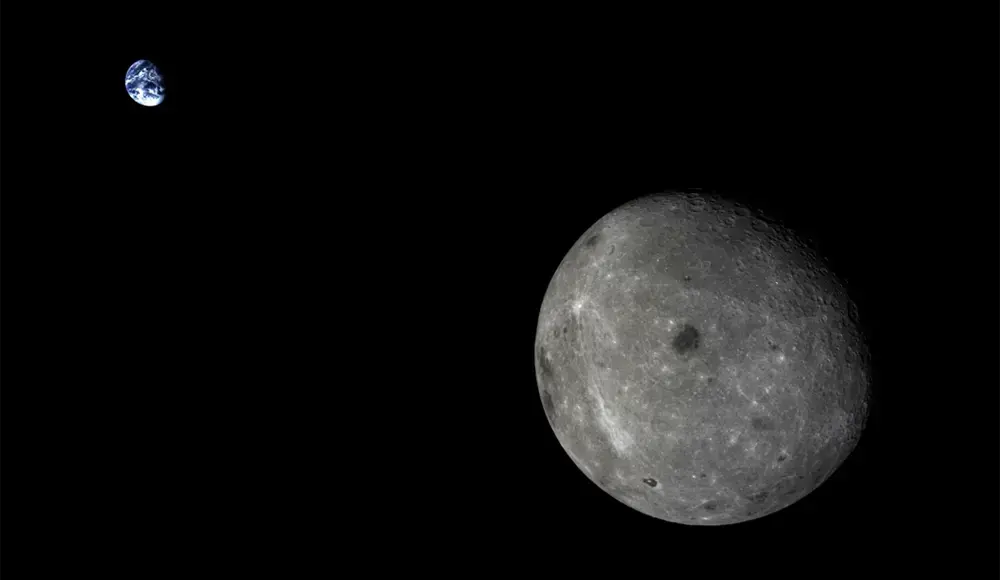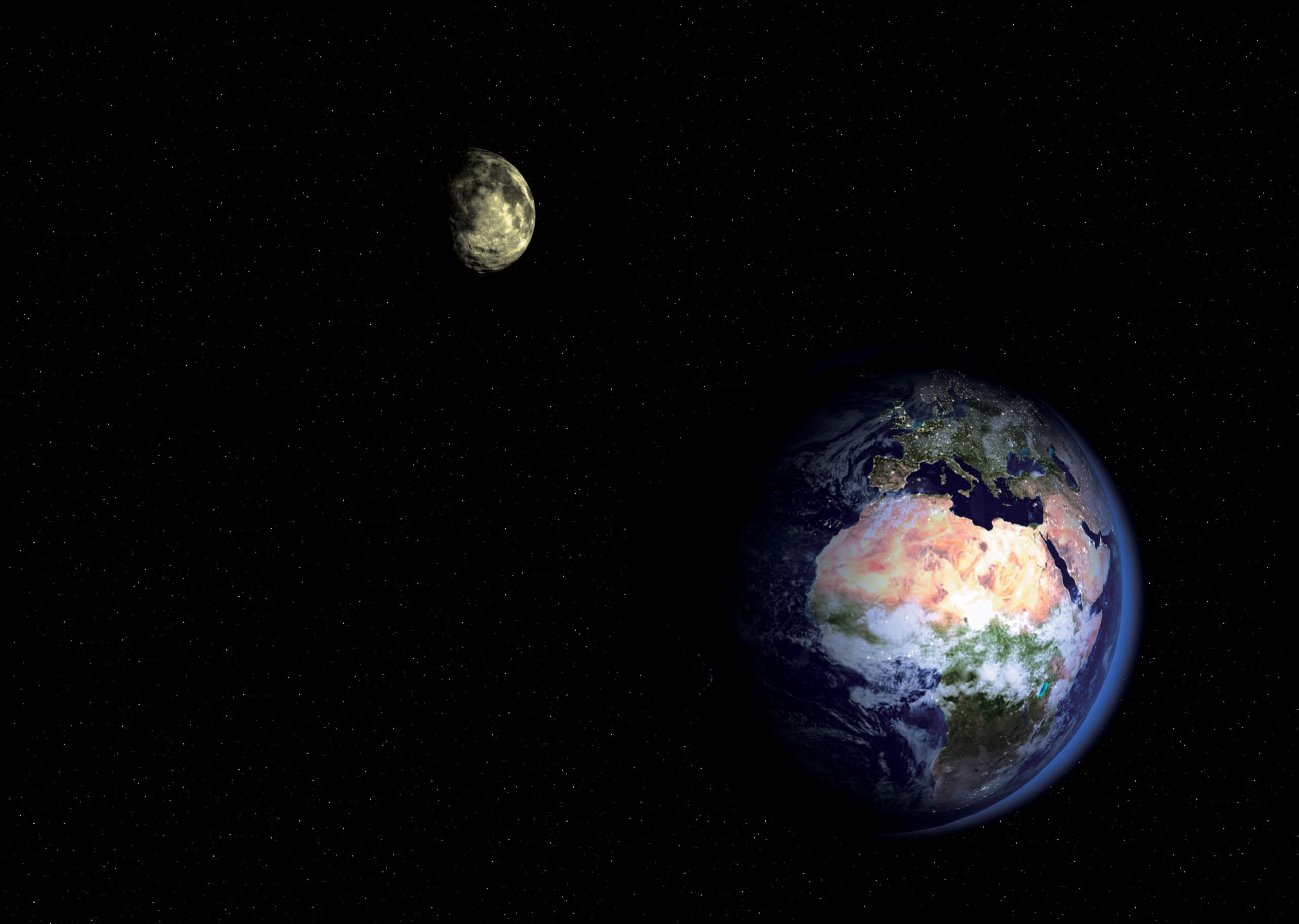This article was originally authored by Dr. Hugh Ross and is republished here with permission from Reasons to Believe, a ministry dedicated to integrating science and faith. All rights reserved by the original publisher. To explore more resources, visit their website Reasons to Believe.
Is it significant that Earth and the Moon shared a magnetic field about 4 billion years ago? Research shows that it is. Scientists have learned that a coupled magnetosphere shared magnetic field between Earth and the Moon helped shield our planet from the young Sun’s radiation that would have been catastrophic for life.
Textbooks used to describe the Moon as having no magnetic field now and never having had one of any consequence. However, the magnetometer delivered to the Moon by the Apollo 12 astronauts in 1969 revealed that the Moon does have a magnetic field, albeit a thousand times weaker than Earth’s present magnetic field. This lunar magnetic field is a leftover magnetic memory of the earliest lunar eras preserved in the Moon’s surface rocks. Laboratory analysis of lunar rocks brought to Earth by Apollo astronauts revealed that the Moon must have possessed a substantial magnetic field during the several hundred million years after its formation.
Below I provide scientific details about a previous analysis and a new discovery in the next two sections. If they seem too technical, feel free to skim and begin again at Implications.
Moon early magnetic and dynamic history
Laboratory analysis of the lunar rocks established that, 4.25 to 3.50 billion years ago, the Moon’s maximum magnetic field strength ranged from 20 to 100 microtesla 0.2 to 1.0 gauss. [1] From 3.50 to 3.20 billion years ago, the Moon’s maximum magnetic field strength dropped to about 5 microtesla 0.05 gauss. These measurements compare with Earth’s present maximum magnetic field strength of 65 microtesla 0.65 gauss.
For both Earth and the Moon the magnetic field strength varies according to where one is located on the surface. Earth’s present surface magnetic field strength ranges from 23 microtesla 0.23 gauss in Paraguay to 65 microtesla 0.65 gauss between Tasmania and Antarctica.
Previous to 3 billion years ago, the Moon was much closer to Earth. The Earth and Moon separation was only about 21 Earth radii 133,800 kilometers or 83,100 miles 3.9 billion years ago and only about 18 Earth radii 114,700 kilometers or 71,300 miles 4.0 billion years ago. [2] The present Earth and Moon separation is 384,400 kilometers or 239,000 miles.
For the Moon to possess a strong magnetic field, there would need to be strong enduring convection currents circulating in its liquid iron core. Internal heat remaining from the Moon formation event kept the Moon’s iron core liquid previous to 3.5 billion years ago. Scientists are convinced that the formation event was brought about by the collision and merger of Theia, a planet 11 to 15 percent of Earth’s present mass, with the proto Earth. [3] The Moon’s proximity to Earth previous to 3.5 billion years ago provided the required convection currents. Earth’s gravity on the Moon’s side nearest Earth would have been significantly stronger than Earth’s gravity on the Moon’s far side. The difference in the gravitational strengths caused the Moon to experience a substantial wobble. A much smaller wobble persists to this day. This wobbling stirred up the liquid iron in the lunar core, which produced the convection currents that generated the Moon’s strong magnetic field.
Previous to 3.5 billion years ago, the Moon exerted a substantially stronger gravitational pull on Earth’s near side than it did on Earth’s far side. The difference in gravitational pulls generated convection currents in Earth’s liquid iron core. Today, the lunar contribution to convection in Earth’s liquid iron core is several hundred times weaker. It has been replaced by convection driven by the transformation of Earth’s core from entirely liquid to an inner solid and an outer liquid core.
Neither Earth nor the Moon would have possessed a strong enduring magnetic field previous to 3.5 billion years ago if it were not for their close proximity to one another. This proximity at that time also made possible the coupling of their magnetospheres with profound implications for life on Earth.
Earth and Moon coupled magnetospheres
Now, a team of four planetary astronomers led by James Green has shed light on this early coupling of magnetic fields. The team used the known lunar magnetic field strengths and lunar distances from Earth previous to 3 billion years ago along with the known solar wind intensities at the time to determine the magnetospheres for both the Earth and Moon and how the two magnetospheres were coupled. [4] Figures 1 to 4 show what they achieved.




Implications
Green’s team showed that regardless of the orientations of Earth’s and Moon’s magnets, the coupled magnetosphere of the Earth and Moon previous to 4 billion years ago was sufficiently strong and stable to prevent the intense solar wind from sputtering away or seriously degrading either Earth’s atmosphere or its hydrosphere. It also was strong and stable enough to protect the microbes on Earth’s surface at that time from deadly solar radiation.
Then about 3.2 billion years ago, the Moon’s magnetic field became too weak and the Moon too distant from Earth for the Moon’s magnetic field to provide any significant magnetospheric protection for Earth’s atmosphere, hydrosphere, and life. However, by this time it was no longer necessary. The Sun’s flaring activity and intensity of x ray and gamma ray emission had decreased to levels where Earth’s magnetosphere, by itself, would be sufficient to protect Earth’s atmosphere, hydrosphere, and life. See figure 5.

I have written previously that our Moon is like no other known moon. [5] A small rocky planet as close to its host star as Earth is to the Sun being orbited closely by a single enormous Moon requires an extraordinarily fine tuned collision event.
A planet 11 to 15 percent Earth present mass of a just right composition and internal structure must merge with the proto Earth at a just right time in the solar system history in a just right manner just right velocity, just right merge angle, just right rotation direction and rate for a moon like our Moon to form. The required fine tuned designs are so mind boggling that one lunar formation modeler, Tim Elliott, wrote in Nature that it was causing him and his colleagues philosophical disquiet. [6] Now more layers of fine tuned designs must be added, including the early strong magnetic fields of both Earth and the Moon resulting from their proximity to one another and the coupled magnetosphere history of the Earth and Moon system.
Green and his colleagues close their paper by explaining that they have uncovered yet another habitability requirement. For a planet other than Earth to host anything more than a few microbial species for more than a brief time period it must host a moon virtually identical to ours. Such a planet and moon system must possess both a coupled dynamical history and a coupled magnetosphere history virtually identical to the Earth and Moon system. I would add that such a planet and moon system must orbit a star virtually identical to the Sun since stars more massive or less massive than the Sun pose an even greater risk to the planet atmosphere, hydrosphere, and life. [7]
The four planetary astronomers do not comment any further, but as an astronomer I would also observe the additional habitability requirements they uncovered demand such exceptional fine tuning as to rule out any reasonable naturalistic explanation for how any planet in the universe could become a home for long term life or for any conceivable multicellular life. The only reasonable explanation for such a planet and Earth and Moon system is that it is the product of a super intelligent, supernatural Being who created a home where humans can exist, thrive, and enter into a personal relationship with the cosmic Creator.
Featured image Moon and Earth
Image credit Chinese National Space Administration, Xinhuanet
Endnotes
- Saied Mighani et al., “The End of the Lunar Dynamo,” Science Advances 6, no. 1 2020 id eaax0883, doi 10.1126/sciadv.aax0883. ↑
- V. N. Zharkov, “On the History of the Lunar Orbit,” Solar System Research 34, no. 1 2000 1, abstract. ↑
- Hugh Ross, “Lunar Coincidences Lead to Philosophical Disquiet,” Today’s New Reason to Believe blog 2014 and Improbable Planet Baker 2016 pages 48 to 60. ↑
- James Green et al., “When the Moon Had a Magnetosphere,” Science Advances 6, no. 42 2020 id eabc0865, doi 10.1126/sciadv.abc0865. ↑
- Hugh Ross, multiple posts on the unique nature of the Moon and updates on lunar magnetism 2020 and later. ↑
- Tim Elliott, “A Chip Off the Old Block,” Nature 504 2013 90, 10.1038/504090a. ↑
- Hugh Ross, Weathering Climate Change RTB Press 2020 pages 117 to 126. ↑
Go deeper

Dr. Hugh Ross
Hugh Ross is the founder and senior scholar of Reasons to Believe, an organization dedicated to communicating the compatibility of science and the Christian faith. While in college, Hugh committed his life to Jesus Christ after his study of cosmology convinced him of the existence of a Creator, specifically the God of the Bible. Hugh holds a degree in physics from the University of British Columbia and a PhD in astronomy from the University of Toronto. After five years on the Caltech faculty, he transitioned to full-time ministry and still serves on the pastoral team at Christ Church Sierra Madre. His writings include journal and magazine articles, hundreds of blogs, and numerous books-Why the Universe Is the Way It Is, Improbable Planet, Designed to the Core, and Rescuing Inerrancy, among others. He has spoken on hundreds of university campuses as well as at conferences and churches around the world and participates in the weekly Stars, Cells, and God podcast.





Leave a comment